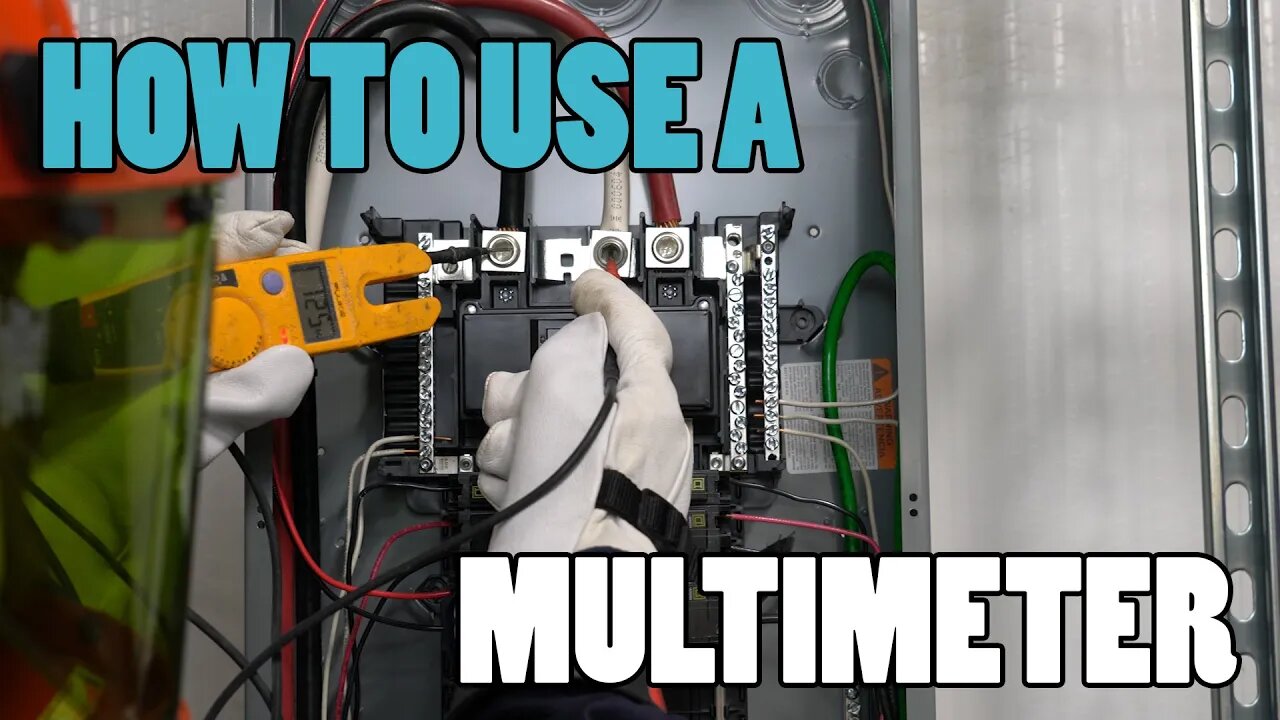Premium Only Content

How To Use A Multimeter - USING THE FLUKE T5-600 TESTER
Many up-and-coming electricians have trouble understanding how to use the various electrical testers out on the market. All of the dials, characters, and options can get a bit confusing if you don’t have experience using a multi-meter. In this episode, I talk about how to use a commonly used tester, the Fluke T5-600.
USED IN THIS VIDEO:
https://amzn.to/2JDso7M - Fluke T5-600 Tester
https://amzn.to/2Jz7LK9 - Fluke CL323 Clamp-On Ammeter
https://amzn.to/2YOZcBs - Hard Hat
https://amzn.to/2Gacwci - Jacket
https://amzn.to/2G7V6wV - Rubber Glove Inserts
https://amzn.to/2JreOFV - Leather Glove Protectors
https://amzn.to/2S8Zhxc - Pants
👾🤖PRACTICE EXAMS🤖👾
https://www.electricianu.com/practice-exams
😎👕MERCH👕😎
https://www.electricianu.com/merchandise
📲👥SOCIALS👥📲
Instagram - https://www.instagram.com/electrician_u
Discord - https://discord.gg/7ykYfbh
Facebook Page - https://www.facebook.com/theelectricianu
Facebook Group - https://bit.ly/2tz7eQh
TikTok - https://www.tiktok.com/@electricianu
SPONSOR
ROGERS - https://www.rogersservices.com
Technically the fluke T5 is not a “multi-meter.” Fluke’s website lists it as a “tester,” while their Multimeter section shows only digital multimeters with no separate jaw-type ammeter. However, a multi-meter is simply a “multi-use meter” - something that can test several different electrical units of measure. The T5 measures voltage, amperage, resistance, and continuity. There are other multi-meters out there that have extra functions but the T5 is for the basic 4 that most electricians will use every day. So how do we use it?
VOLTAGE -
What you’re doing when you’re testing for voltage is testing the difference of potential between two points. “Voltage” is a difference of potential between two points in an electrical system. It is not a reading of one conductor, it's reading a difference between two. It can even be a difference between one wire and a piece of metal that’s bonded to earth. But keep in mind that you’re trying to get a value that shows “the difference in potential” between TWO things.
Flip the dial of the T5 to the “V” and take the leads out of the slide-in slots on the back. Ensure that you’re wearing proper PPE such as insulated “hot-gloves,” and a flash suit if you’re working in an electrical panel. Take one lead and touch it to a known hot conductor or terminal. Take the other lead and touch it to that same conductor or terminal. Notice you get a reading of 0v. This is because this conductor is at the same potential as itself. To get a voltage reading you have to test between two different objects.
AMPERAGE -
How to use the amperage setting - Flip the dial to the “A” (Amperes). Line your wire up with the two lines inside of the jaw of the ammeter. Only measure one wire at a time. This tester will give you readings up to 100 amps, so for anything more than that you’ll need a larger tester. This makes sense since the max size wire you can fit in the ammeter is 1/0 THHN. If you have larger wires than 1/0 THHN then you’ll need to get your hands on a clamp-on ammeter.
RESISTANCE -
Flip the dial to the Ohm (Omega) symbol. For this you want to test on a dead circuit so make sure the power is shut off. To test a conductor’s resistance you will need to have access to the beginning and the end of the conductor. Put one lead on the beginning of your conductor and one lead and the end of your conductor. This meter will display how many ohms of resistance there is between the leads. When there is low resistance you will hear a loud toning noise. When you try testing a really high resistance the tester will stop emmiting a tone, and will instead just display values. This meter is only good for up to 1,000 ohms. Anything more than 1,000 ohms should really be tested with a megger (megohmmeter)
CONTINUE READING AT: https://www.electricianu.com/podcast/episode-25-how-to-use-a-multimeter-using-the-fluke-t5-600-tester
#fluke #multimeter #electrician #tester
--
Subscribe - https://www.youtube.com/c/electricianu?sub_confirmation=1
IF YOU ENJOY THESE VIDEOS PLEASE SUBSCRIBE AND "LIKE" THEM ABOVE.
-
 6:27
6:27
Electrician U
1 year ago💡 Watts vs Lumens: The New Lighting Standard You Need to Know! 💡
7.01K6 -
 1:45:26
1:45:26
Kim Iversen
11 hours agoBANNED for Telling the Truth: The 9/11 and Epstein Plot They Don't Want You To Hear
111K137 -
 1:08:47
1:08:47
Man in America
14 hours agoDr. Makis EXPOSES Big Pharma’s SICK Vaccine Scam—RFK Jr. Must Act NOW!
96.1K23 -
 1:28:21
1:28:21
Glenn Greenwald
12 hours agoRFK Jr. Hearing Reveals DC Pro-Pharma Consensus; Trump's Executive Order to Deport Student Protesters Criticizing Israel; Untangling DC Think Tank Funding & Influence | SYSTEM UPDATE #399
142K165 -
 1:23:44
1:23:44
Space Ice
12 hours agoSpace Ice & Redeye: Van Damme's The Quest: Pirates, Clowns, James Bond & Bloodsport
47.1K3 -
 59:57
59:57
The StoneZONE with Roger Stone
10 hours agoJ6 Martyr Enrique Tarrio Describes Inhumane Prison Conditions Ordered by Biden | The StoneZONE
44.5K4 -
 16:48
16:48
Tundra Tactical
10 hours ago $8.05 earnedAffordable Medical Gear From ACETAC SHOT Show 2025
74.3K3 -
 1:46:16
1:46:16
Redacted News
13 hours agoRFK CONFIRMATION: Kennedy goes to WAR with Big Pharma Democrats in Fiery Hearing | Redacted Live
257K427 -
 57:31
57:31
Candace Show Podcast
13 hours agoBREAKING! Taylor Swift Turns Against Blake Lively & Ryan Reynolds | Candace Ep 141
235K186 -
 1:04:59
1:04:59
Sarah Westall
10 hours agoRFK Jr Report, Constitution Suspended, War Time Procedures in Place, WHO Exit, DOD w/ Sasha Latypova
77.2K35